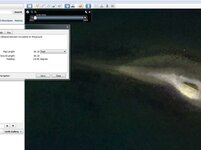Dave Rishar
Silver Member
Google Earth will only let you go as far back as 2002 in that area, but the 2002 image really does show how quickly that island is eroding. It also shows a rock pile that looks quite a bit different, but I'm not sure what to make of that.
FK, what is your 59 foot figure based on? Is it just kind of an average? Existing examples vary quite a bit in length, both longer and shorter than 59 feet.
FK, what is your 59 foot figure based on? Is it just kind of an average? Existing examples vary quite a bit in length, both longer and shorter than 59 feet.





 ? any thing on the island and around the island to hold back the tide is gone back into the ocean and washed away. So how did the metal make its way 1' to 2' under the stones. I had many questions like you have but there is no way to answer them NOW. I will not make the same mistake in New Ross. We have a lot of proof of a castle at this site. Ya Joan Hopes info sounds crazzy but if you went to this site you would see things that would mess up your mind to. Things happen on site every day. The neighbors still see things. We have seen things we will not talk about yet. If we did we would sound just like Joan Hope. Joan had a high IQ and she knew if she put some of her stories on the web people would make fun of her BUT she still did. WHY. Because the things she saw did happen . I am sure things happen on Oak Island to. No Big Foots or UFO but there is some kind of energy or power or something in this area doing this. May be some day we will know. This is part of what we do besides hunting for treasure. I have many questions like everyone but who can answer the weard things that happen. So we will continue our trips back to New Ross until we get answers. Thank You
? any thing on the island and around the island to hold back the tide is gone back into the ocean and washed away. So how did the metal make its way 1' to 2' under the stones. I had many questions like you have but there is no way to answer them NOW. I will not make the same mistake in New Ross. We have a lot of proof of a castle at this site. Ya Joan Hopes info sounds crazzy but if you went to this site you would see things that would mess up your mind to. Things happen on site every day. The neighbors still see things. We have seen things we will not talk about yet. If we did we would sound just like Joan Hope. Joan had a high IQ and she knew if she put some of her stories on the web people would make fun of her BUT she still did. WHY. Because the things she saw did happen . I am sure things happen on Oak Island to. No Big Foots or UFO but there is some kind of energy or power or something in this area doing this. May be some day we will know. This is part of what we do besides hunting for treasure. I have many questions like everyone but who can answer the weard things that happen. So we will continue our trips back to New Ross until we get answers. Thank You



